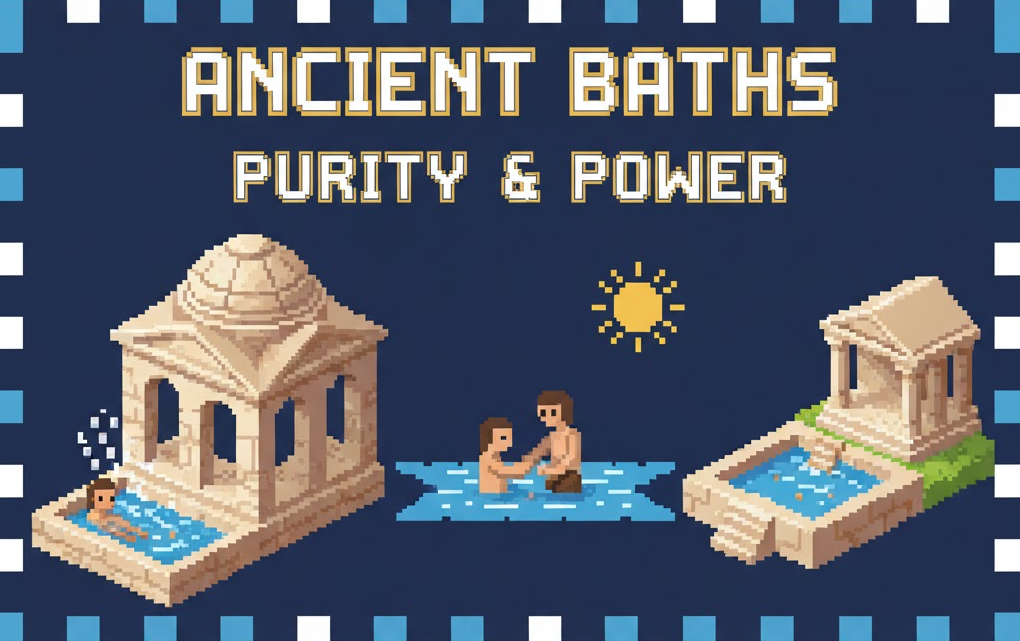I. Introduction: Defining the Ancient Bathing Paradigm
The analysis of bathing practices in the ancient world offers a profound lens through which to examine social structure, technological capability, and religious philosophy. Far from being a mere hygienic necessity, the treatment and use of water—whether in vast communal structures or small ritual pools—functioned as a central indicator of civilizational commitment. This report provides an exhaustive comparative synthesis, contrasting the pragmatic, communal, and health-centric traditions prevalent in the West (Greco-Roman) with the sacred, purity-driven traditions rooted in the East (Jewish, Persian, and Phoenician). The geographical scope extends from Bronze Age precursors through the late Imperial periods, demonstrating a fundamental divergence in the ultimate purpose of immersion and ablution.
A. Scope, Cultural Geography, and Methodology
The methodology employed herein is comparative, highlighting how different cultures either embraced water for social integration and physical wellness or mandated strict protocols for its use to preserve spiritual or elemental sanctity. The evolution of bathing infrastructure—from early individualized tubs to colossal thermal complexes—serves as a physical record of societal values and priorities. The analysis demonstrates that the organization of water resources was not uniformly pragmatic; in many cases, it was dictated by deep-seated theological requirements.
B. Precursors and Deep Origins: Establishing the Antiquity of Structured Bathing
The concept of structured water use for communal or ritual purposes is demonstrably pre-classical. The earliest known examples of large-scale architecture dedicated to bathing or water storage exist outside the Mediterranean orbit, highlighting independent technological ingenuity and a foundational commitment to purification.
- The Indus Valley Civilization (c. 3rd millennium BC): The "Great Bath" at Mohenjo-daro is recognized as the earliest public water tank identified in the ancient world. This massive structure, featuring finely fitted, bitumen-waterproofed bricks, suggests a deep foundational commitment to communal life, most likely for special religious purification functions.
- Minoan Crete (c. 3100 – 1100 BC): The Bronze Age Minoan civilization was known for its advanced hydraulic systems within its monumental palaces. The specific function of these early Aegean structures in daily and cultic life remains a subject of ongoing debate.
C. The Dual Function of Water: Hygiene, Health, and Holiness
Ancient bathing practices cannot be analyzed purely through a modern hygienic perspective. For most cultures, water use was a convergence of physical cleansing, social convention, and spiritual transformation. While the Roman system would ultimately emphasize the communal, physical, and medical benefits, the earlier and concurrent Eastern models centered the practice on ritual status and spiritual fitness, demonstrating that the function of water was deeply bifurcated across the ancient world. The significant engineering effort required to manage water—such as the massive aqueduct systems for Roman *thermae*—shows that the provision of infrastructure was consistently a critical investment.
II. The Western Model: Secular, Social, and Architectural Dominance (Greece and Rome)
The Greek and Roman civilizations established the Western paradigm for bathing, transforming the practice from a functional activity associated with athletic training into a comprehensive social and architectural phenomenon rooted in preventative health philosophy.
A. Greek Foundations: From Athletic Cleanliness to Public *Balaneia*
Early Greek bathing was functional, initially involving primitive steam baths and later facilities built alongside athletic fields, known as *balaneia*. These structures often included round rooms (*tholoi*) with individual hip- or long-tubs. Access was often tied to agonistic activities, primarily serving the male youth of the wealthier classes and athletes. Originally cold-water cleansing (*loutron*) post-exercise, many facilities later incorporated heated wash-rooms.
B. The Roman Revolution: *Thermae* as the Engine of *Romanitas*
The Romans radically monumentalized the Greek tradition with state-owned, colossal multi-purpose complexes known as **thermae**. These structures, epitomizing luxurious experience, could accommodate thousands of bathers and became potent symbols of *Romanitas* (Roman identity). This scale was possible only through vast aqueduct systems, which prioritized the water supply for public baths, demonstrating the state's valuation of public health and social cohesion over private convenience.
- Architectural Zenith: A Roman catalogue from 354 AD documented 952 baths in the city of Rome alone.
- Social Access and Democratization: Fees were kept at the lowest coin denomination, making daily bathing accessible even to the poorest free Roman male. The baths served as powerful venues for recreation and political networking across social classes.
The fundamental difference was the state’s massive subsidy, transforming bathing into a subsidized, universal social entitlement that solidified imperial control and cultural assimilation throughout the provinces.
III. The Eastern Model: Water, Purity, and Religious Imperative
In stark contrast to the secular, socialized bathing of the Greco-Roman world, the traditions of the Near East primarily centered water use around concepts of ritual purity and religious sanctity, creating a different set of architectural and social constraints.
A. Jewish Bathing: The Pursuit of Purity (*Mikveh* and *Taharah*)
Jewish water practice is dictated by the laws of spiritual purity (*taharah*). The central institution is the **mikveh** (ritual bath), designed for ritual immersion required after specific forms of impurity. Immersion is understood as a symbolic act of self-abnegation and spiritual rebirth, focusing on the metaphysical state rather than physical cleanliness alone. The religious emphasis on cleanliness inadvertently produced superior public health outcomes, making bathing a matter of ritual necessity.
B. New Testament Baptism: The Special Bath of Purification
The concept of ritual immersion (*mikveh*) laid the foundation for the Christian practice of baptism. In the New Testament, baptism is understood not as a hygienic measure, but as a profound spiritual act—a special kind of bath that effects purification and reconciliation. The Greek word for baptism, *baptizō* ($$\beta\alpha\pi\tau\acute{\iota}\zeta\omega$$), literally means to immerse, plunge, or wash. The New Testament writers present this act as:
- Identification with Christ's Death and Resurrection: Baptism is described as being buried with Christ and rising to new life (Romans 6:4, ESV), symbolizing purification from sin and a spiritual rebirth.
- The Cleansing of the Conscience: The apostle Peter refers to baptism as "an appeal to God for a good conscience" (1 Peter 3:21, ESV). It is the external action that signifies an internal, spiritual cleansing, fulfilling the ritual longing for *taharah* found in Jewish tradition, but through divine grace rather than mere water ritual.
- Washing and Sanctification: The act is frequently linked to purification, such as in Acts 22:16, where Saul is told to "rise and be baptized and wash away your sins." This recontextualizes the ancient concept of water as an agent of purification from physical or ritual impurity, transforming it into the means of spiritual purity within the new covenant.
In essence, New Testament baptism serves as the ultimate theological evolution of the ancient Eastern focus on water-based purification, moving its purpose from cyclical ritual cleansing to a singular, foundational act of spiritual transformation.
C. Persian Bathing: The Sanctity of Water (Zoroastrianism)
Ancient Persian culture, particularly under Zoroastrianism, revered water as a holy element. Polluting or wasting water was considered a grave sin. Rituals like *pādyāb*, a sacred washing, were mandated for purification before religious ceremonies. This reverence often led to restrictions on public, communal baths due to clerical fears of mass pollution of the holy element, showing a divergence between theology and public health infrastructure.
D. Phoenician Traditions: The Intermediary and Distinct Style
The Phoenician culture developed a distinctive style of bathing suite, primarily found in elite residences, that involved "cleansing bathing." These facilities featured large, low basins not conducive to full immersion and typically lacked heating, suggesting standing washings for elite or priestly preparation. This non-immersion washing approach marks a distinctly separate cultural trait, one that resisted the widespread adoption of Greek immersion styles until the Roman conquest.
IV. Medical Philosophy and Health Benefits
A. The Humoral Framework: Hippocrates and the Origins of Hydrotherapy
Ancient Greek medicine, driven by the intellectual shift toward physical cause-and-effect, founded the practice of hydrotherapy. Hippocrates advised controlled bathing and perspiration to restore the balance of the four bodily fluids, or humors. This marked the formal beginnings of using bathing for therapeutic purposes.
B. Galenic Integration: Bathing as a *Res Non Naturalis*
Romans formalized the health regimen under physicians like Galen of Pergamon. Galen established six controllable factors, the *res non naturales*, which influenced humoral balance, with bathing regarded as a crucial component. The medical profession fully supported bathing as a vital therapeutic and preventative measure.
C. Regimen and Therapy: The Structured Bathing Sequence
The Roman *thermae* architecture directly manifested this medical theory. The structured visit—involving exercise, oiling/massage, heating/sweating (*tepidarium*, *caldarium*), and final cooling (*frigidarium*)—was a carefully calibrated physiological process designed to maintain humoral equilibrium. The state-sponsored thermal complex functioned essentially as a large-scale, subsidized public health clinic.
V. Synthesis and Conclusion
The study of baths and bathing in the ancient world reveals a fundamental schism between cultural intent and architectural outcome. The practice of bathing, regardless of culture, was an essential activity, but the underlying philosophy and resultant social accessibility varied dramatically.
A. The Divergence of Purpose: Socialization vs. Sanctification
The Roman **thermae** represented the apex of secular, communal bathing, functioning as a social theater and fitness center with universal access. Conversely, the Eastern traditions prioritized spiritual status and purity. The new section on New Testament baptism highlights the theological culmination of this Eastern purity focus, moving the practice from cyclical ritual to a singular act of spiritual transformation.
| Culture | Primary Function/Philosophy | Widespread Nature | Access Profile |
|---|---|---|---|
| Roman | Communal Leisure, Preventative Health | Extremely widespread, daily activity | Accessible to virtually all classes (nominal fee) |
| Greek | Post-Exercise Cleansing, Civic Life | Widespread in cities | Primarily targeted wealthier male youth/athletes |
| Jewish | Ritual Purity (*Taharah*), Sanctification | Required for specific life events | Communal facilities essential; private baths a luxury |
| Christian (NT) | Spiritual Purification, New Covenant Identity | Fundamental, singular rite of initiation | Theologically universal |
| Persian | Protection of Sacred Water, Ritual Purity | Ritual ablutions mandatory; public bathing contested | Access often limited/opposed by clergy |
| Phoenician | Priestly/Elite Cleansing, Ritual Preparation | Elite/ritual use; distinct local style | Separate from Greek/Judaean immersion styles |
B. Medical Justification and the Preventative Focus
The sophistication of Greco-Roman bathing lay in its explicit connection to medical science. The structured bath was intrinsically linked to maintaining health through the regulation of lifestyle factors, a core concept detailed by medical authorities.
| Medical Authority | Core Philosophical Concept | Role of Bathing/Water |
|---|---|---|
| Hippocrates (Greek) | Humoral Theory | Hydrotherapy to restore equilibrium |
| Galen of Pergamon (Roman) | *Res Non Naturales* (Six controllable factors) | Preventative measure for health preservation |

